
Developing a content marketing strategy that works is hard. You need to understand your audience very well. You also need to consistently create high-quality content, so you can get people to share and link your content, all with the hopes of getting people to visit your site. The only downside is this process takes a lot of time. And even if you do everything right, you may not get the traffic you need.
What if there was a way to cut through these problems and get the results you want? Fortunately, there are not one, but seven ways to do so. Below are seven growth hacks to improve your content marketing and ignite your site’s traffic. (And be sure to check out the bonus resource at the end of this article with a checklist of all the things you need to do to implement each hack.)
(And be sure to check out the bonus resource at the end of this article with a checklist of all the things you need to do to implement each hack.)
1. Discover Which Content Will Get You Inbound Links
In the past 10 years, Google has made many changes to its ranking algorithm. These changes have had many goals and effects, but the most important one was to change the way pages ranked.
Up until Panda (the first big algorithm change made in February 2011), many sites were able to rank their pages just by getting a lot of low-quality links. This decreased the quality of Google’s results. Many things were said after those changes were made, from “SEO is dead” to “content is king.”
Despite all these changes, links still matter. They are considered by many SEO experts as one of the most important ranking factors. However, not every link is worth the same. Their quality is what matters now, not their volume. And since there aren’t that many high-quality sites out there that easily link out to other sites, it’s hard to get them.
Today, there’s only one way to get high-quality links: You need amazing content that’s link-worthy. With this content, you need to make high-quality sites link to your site. To do that, you need to know how to reach the people that run those sites to make them link to you.
None of this is easy. It takes a long time to develop the skills to do it. But still, even if you do everything right, those people may not find your content link-worthy. You are always betting your idea will work and will make people link to you.
As it turns out, there’s a better way to get inbound links to your content, and that’s what this hack is all about. The idea is to reverse engineer content that already has gotten lots of links, create a similar yet better piece of content, and then promote it to the people that linked to the original content, so they end up linking to the new and “improved” one. This is the same idea that Brian Dean from Backlinko has made so famous (which he coined as the “Skyscraper technique”).
First, you need to pick a piece of content that ranks well in search engines. In our case, I will search for “how to rank a page in Google.” These are the results that Google showed me:
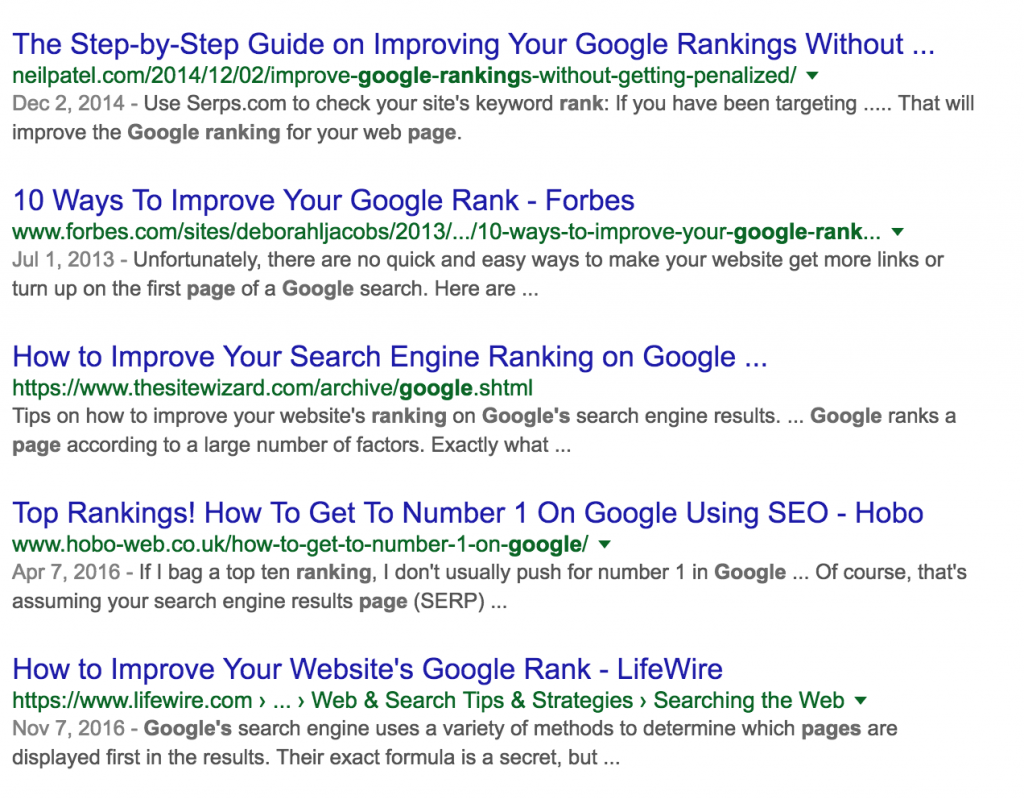
Most of the sites in the top 10 results are highly authoritative sites.
Then, I took each of these results and pasted them onto Open Site Explorer (OSE, for short). After analyzing the result with the OSE, I found that the Forbes article “10 Ways To Improve Your Google Rank” has 138 inbound links that come from 52 domains, some of which belong to high-authority sites.
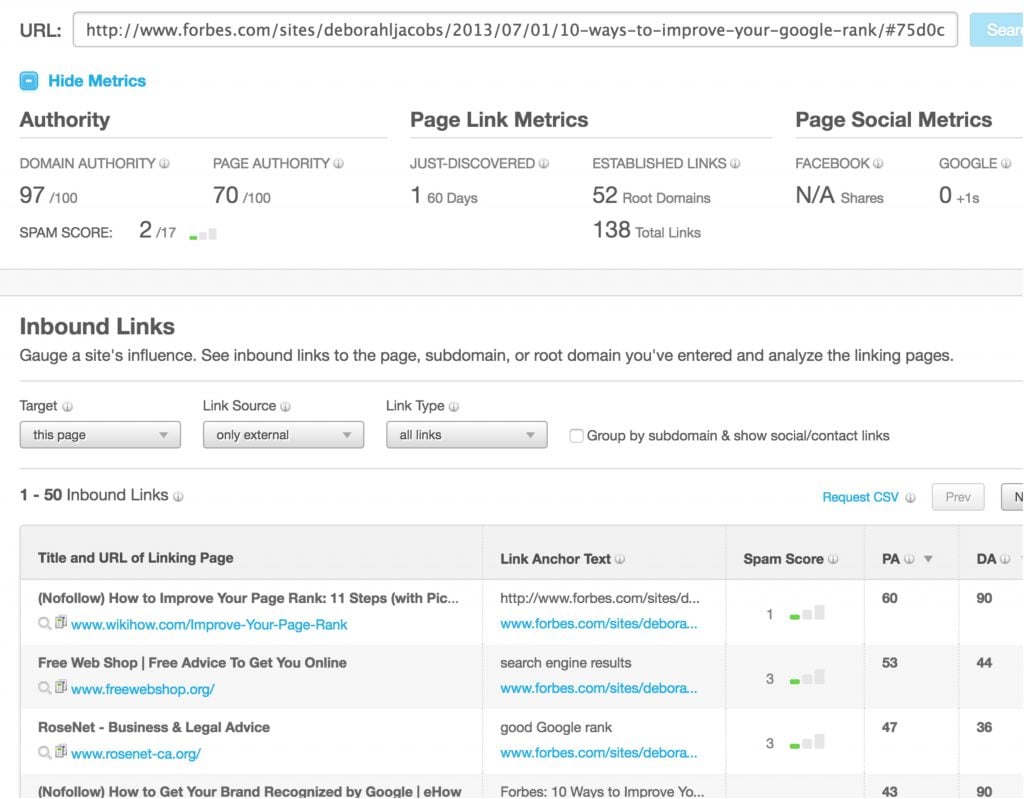
With this data, I now know that an article like the one from Forbes is link-worthy. Thus, I can create a piece of content that is similar to but better than the Forbes one. Once I publish that piece of content, I can offer it to the same sites that linked to the Forbes article to get them to link to my content.
It’s not easy to find great opportunities, but if you take your time and do enough searches, you will find unique link-worthy content opportunities.
2. Find Content Your Readers Will Share
If it’s hard to make people link to your content, then it’s almost as hard to make them share it. Every second, social media users publish 216 thousand Instagram posts and 217 thousand tweets. How can you make someone stop in their tracks, skim your content, and make it worthy of their retweet or like?
One theory focuses on designing a piece of content to make it more likely for it to go “viral.” This theory, developed by Jonah Berger, author of the book Contagious, explains that there are six principles of viral marketing:
- Social Currency
- Triggers
- Emotion
- Public
- Practical Value
- Stories
But even if you add all these elements to your content, people still may not share it. At the end of the day, it’s hard to predict what people will find share-worthy. Remember, there’s way too much information going on every minute.
However, there’s a way to hack this problem. This hack uses a competitive intelligence tool called Buzzsumo to reverse engineer a piece of content that already has a lot of shares. As you’ll see, it’s an adapted version of the previous hack.
First, go to Buzzsumo, and make a search using a broad keyword. In this case, we will put the word “content marketing hacks”. This is what Buzzsumo returned:
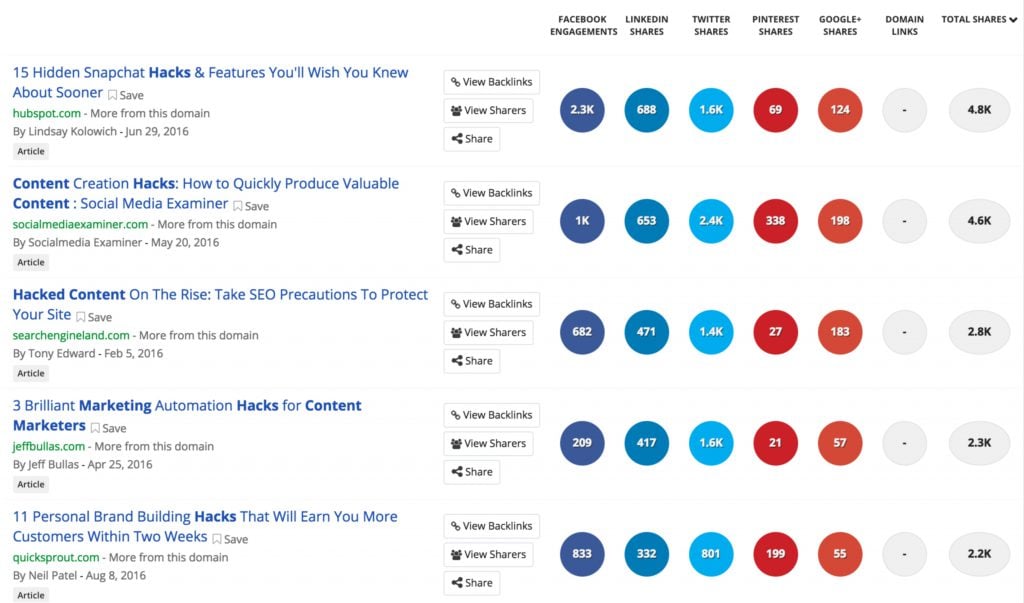
As you can see, many pieces of content related to this keyword have gotten over one thousand shares in the past year.
With this data, we can uncover several patterns that give us some insight on what people like sharing. In this example, we can see people have shared social networks hacks (in this case, Snapchat), hacks to create content faster, and hacks for marketing automation.
With these ideas, we can create a new piece of content, and as we did in the previous hack, and make it better. For instance, we could create an article called, “10 Hidden Hacks for Instagram Stories that You Didn’t Know Existed.”
After we publish the article, we’d promote it as we would in any other article. However, the key in this hack relies on reaching out to the same influencers that shared the similar but less amazing article before. After all, if those people found the previous article interesting, it’s because they probably liked it and would consider sharing something just as good.
3. Make Email Signups a No-Brainer
“The money is in the list,” or so says one of the most famous phrases of the online marketing world. Despite being cliché, it’s right—according to the Digital Marketing Association from the UK, the ROI of email marketing is 3800 percent. In other words, for every dollar you spend on email marketing, you get on average $38 back.
Unfortunately, it’s not as easy to get people to subscribe to your email list as you may think. As of late 2016, there were over 1.1 billion websites in the world, 74 million of which used WordPress (making it the most famous blogging platform in the world). Though many of these WordPress sites probably aren’t active anymore, we can safely assume over 30 million blogs exist as of today (around half the total number), many of which have an email list.
The question, then, is not just, “How can you make people subscribe to your list?” Rather, the most important question to ask yourself is, “How do you make your list stand out from the other million lists out there?”
First of all, you would need to provide enough value for them to want to subscribe to your newsletter. But how do you do that? One highly effective way is by offering lead magnets: ebooks or free email courses that teach them something useful.
But there’s another tactic that’s even more relevant and makes it easier for your readers to subscribe to your list: content upgrades. Content upgrades are lead magnets that are created on top of a given piece of content to provide extra value to the reader. To implement this is hack, you only need to follow a very straightforward set of steps:
- After you write an article, create something extra, like a checklist or a PDF version of the article.
- Package that extra content into an ebook, so people can download it.
- Give that ebook out in exchange for your reader’s email.
If, for example, you created an article about “Top 10 Tips to Increase Your Blog’s Traffic,” a content upgrade could provide two extra tips more in exchange for the reader’s email. That way, instead of creating a new lead magnet from scratch, you are giving your readers extra value based on something they already care about. This article has a content upgrade at the bottom, in which I give out a checklist for this guide.
This isn’t a new concept. Many people, including the LeadPages team, have talked wonders about content upgrades before. They use them for one reason: They work like crazy.
- Bryan Harris from VideoFruit is getting an average opt-in rate of 20 to 30 percent .
- Brian Dean from Backlinko improved his overall site conversions by 185 percent using this method.
- Michael Hyatt says he gets a 59.2 percent email conversion rate on one of his articles.
Neil Patel uses content upgrades in almost every blog post he writes:
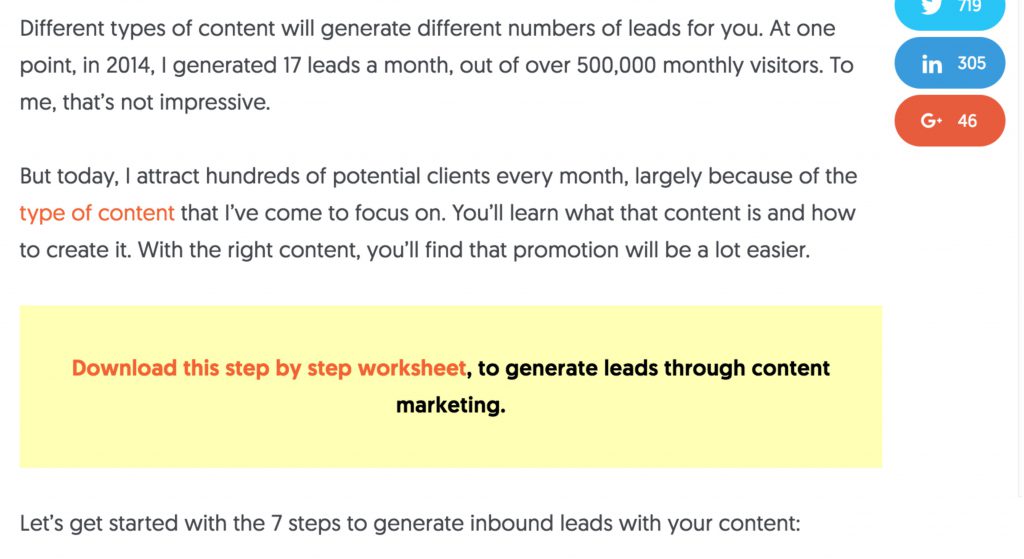
Hubspot, the leading inbound marketing software company, also uses them to increase their email list:
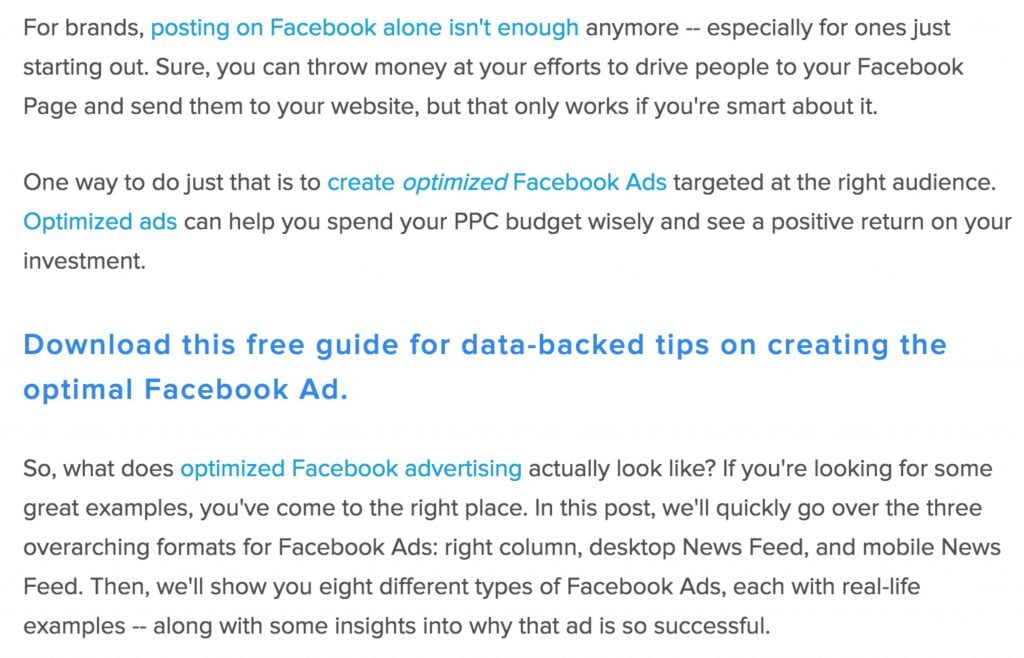
4. Create Content That Ranks Better
So far, we’ve covered that by reverse engineering other blogs’ best content, you can find content opportunities that people like linking and sharing. That’s great, but there’s another way to create content that’s statistically proven to rank better.
You probably have heard the idea that what matters in pretty much everything in life is quality, not quantity. That’s true for content as well, but when it comes to creating content that ranks highly in the search engines, word count matters a lot.
A study by SerpIQ showed that content over two thousand words is statistically more likely to rank in the top 10 Google results. It appears that the closer an article is to the twenty-five hundred-word mark, the better it ranks. On average, tenth position pages have 400 fewer words on the page than first position pages.
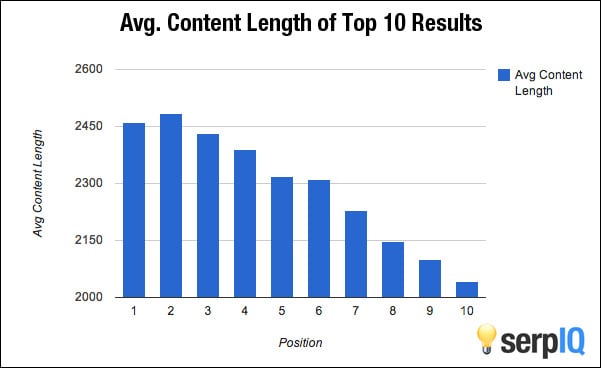
Another study by Brian Dean and Eric Van Buskirk, which analyzed over a million search engine results, came to the same conclusions. In their own words:
“Based on SERP data from SEMRush, we found that longer content tends to rank higher in Google’s search results. The average Google first page result contains 1,890 words.”
In other words, if you create an article over nineteen thousand words, it’s statistically likely to get to the first page results. If it’s over the twenty-five thousand-word mark, it’s likely to rank in the top three results of the search engines.
All in all, create longer content. Don’t do it just for the sake of producing more words—this article is over thirty-five thousand words, and I didn’t do it just because it’s more likely to rank better. I did it because I added as much value as possible, and that took me over two thousand words. If you do the same, you will be able to hack the search engine results.
5. Piggyback Your Traffic
There are dozens of blogs in almost every niche under the sun that get hundreds of thousands of visits per month.
Here’s another interesting, yet sadder, fact: It can take you a lot of time to get to their level, if you ever get there at all. Creating a content hub that gets enough traffic takes a lot of time. There’s no easy way to do it. You can try all the hacks I mention in this article, and you will be able to cut some of that time, but it will still take you months and months to get to, say, 100 thousand monthly visits.
Fortunately, there’s one way you can accelerate that process. Remember the dozens of blogs that get hundreds of thousands of visits per month I mentioned previously? Let me ask you this: What if you could take advantage of their traffic to “piggyback” it to your blog? It turns out you can. Your answer is (ta-dah!) guest posting.
Guest posting is a technique almost as old as Google. Link reciprocity, an ancestor of guest posting, is one of the first link building techniques that ever existed. But after link reciprocity was abused by spammers, Google started penalizing sites that used this technique.
Guest posting is a similar but more legal tactic. You are putting content developed by you on another site, like I am with this article. By doing so, you get a link back. However, just like link reciprocity, guest posting was so abused for SEO purposes only that Google has discounted it from its algorithm. Still, you don’t need to panic and ignore it. It still works, though maybe not as well for SEO as before.
In our case, we’re not looking to get links for SEO (although it helps). Rather, we are looking to attract and build an audience. You want to find high-traffic blogs that are relevant in your industry—blogs where your target audience gets together to learn and discuss.
If you know your industry, you probably know the names of these blogs. If you work, like me, in the SEO industry, you know Moz, Search Engine Land, and Search Engine People are three of the biggest blogs in the industry. If you don’t know what these blogs are, it may take some research on your part to find them. (Don’t worry: The next hack will show you a way to find these blogs.)
Still, publishing an article isn’t enough. You need to make them come to your site. That’s the main goal of this hack.
One way to do so is by publishing often. After all, if they find your content consistently good, they will consider you an authority and visit your blog. There’s no guarantee, however.
Fortunately, there’s a better way. What if you combine the previous hack with this one? What if you created a content upgrade for these blogs? That way, people will not only like your content (and share it), they will also come back to your site, sign up for your list, and become a reader of your blog.
That’s exactly what you will do. To implement this hack, you need to follow the next steps:
- Create a list of 10–20 of the biggest blogs in your industry which accept guest posts or contributions.
- Create a list of the people that run and manage them.
- If these sites have guest posting guidelines and forms, pitch them your ideas.
- If not, reach out to the people that run these sites through social media to build a relationship.
- Once they know you, pitch them your ideas.
- Write the article, and create a content upgrade.
- Publish the article.
- Promote the article as it belonged to your blog.
If the content is really good, and the content upgrade is relevant, many people will come back to your site, and many of them will end up subscribing to your list.
[contextly_auto_sidebar]
6. Find Content Placement Opportunities in Under 10 Minutes
In the previous hack, I mentioned you need to find guest posting opportunities to piggyback your audience. You need to know your industry’s biggest publications to be able to pitch them your article ideas. In some cases, you may not know what blogs are the biggest ones in your given industry.
That’s fine because there are many ways to find these sites. The most common way is by doing some Google searches—duh, right? Doing searches like “best blogs in X,” where “X” is your industry main keyword. That works fine in many cases. Another way is by asking other people and see what they share (remember hack number two). That may be hard if you don’t know many people, but if you do, it can help you cut through the noise.
But there’s a much more effective way to do this which will help you considerably cut your searching time. This hack is all about using the Google Display Planner (or GDP for short). The GDP is similar to the famous Google Keyword Planner, the most commonly used keyword research tool. The GDP, however, focuses on the display network that Google runs—you know, the network that helps you put your banners on other people’s sites for a small(ish) fee.
Instead of using this tool to find display opportunities, we will use it to find sites in your niche and see how many impressions they get per month (which works as a proxy of their traffic).
Let’s use an example. Say that you are in the dog breeding niche. You would add the keywords “dog breeding,” “breeding for dogs,” and “dog mating” (you should add more, but these are the ones I just came up with) and click the “Get placement ideas” button. Here’s how the page would look:
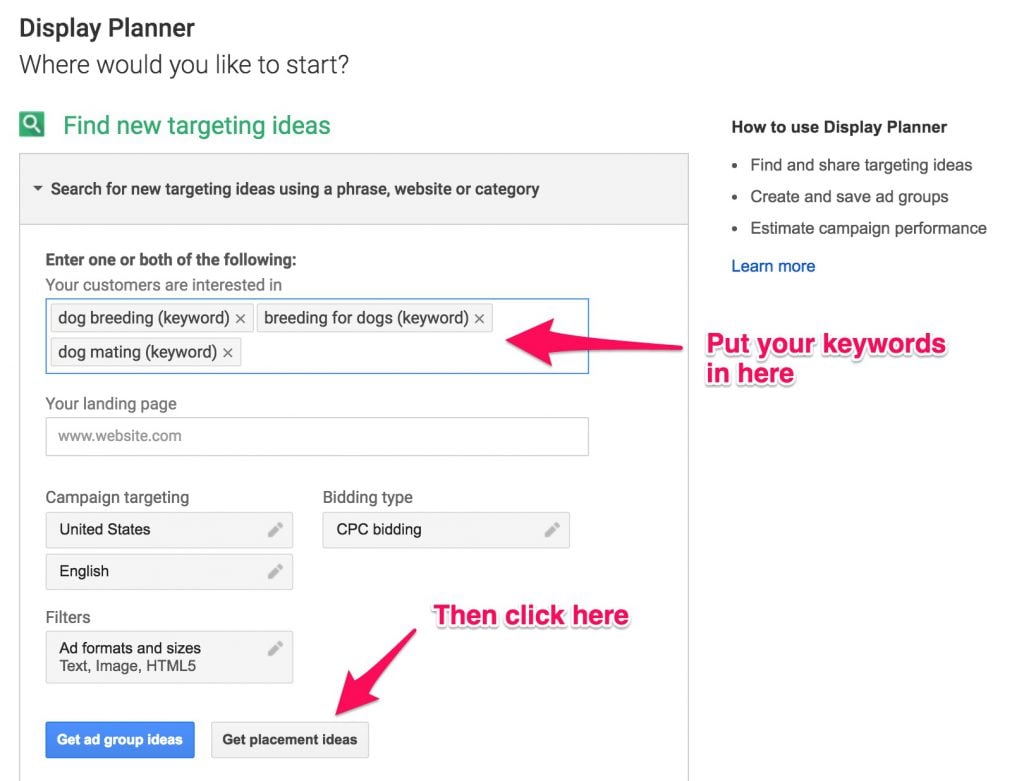
Next, you will see the results for the keywords we put in previously. In this case, I see many anonymous sites and many others that seem interesting. Also, as you can see on the right side of the picture below, I highlighted sites that have over a million impressions per week—in other words, huge sites with lots of traffic.
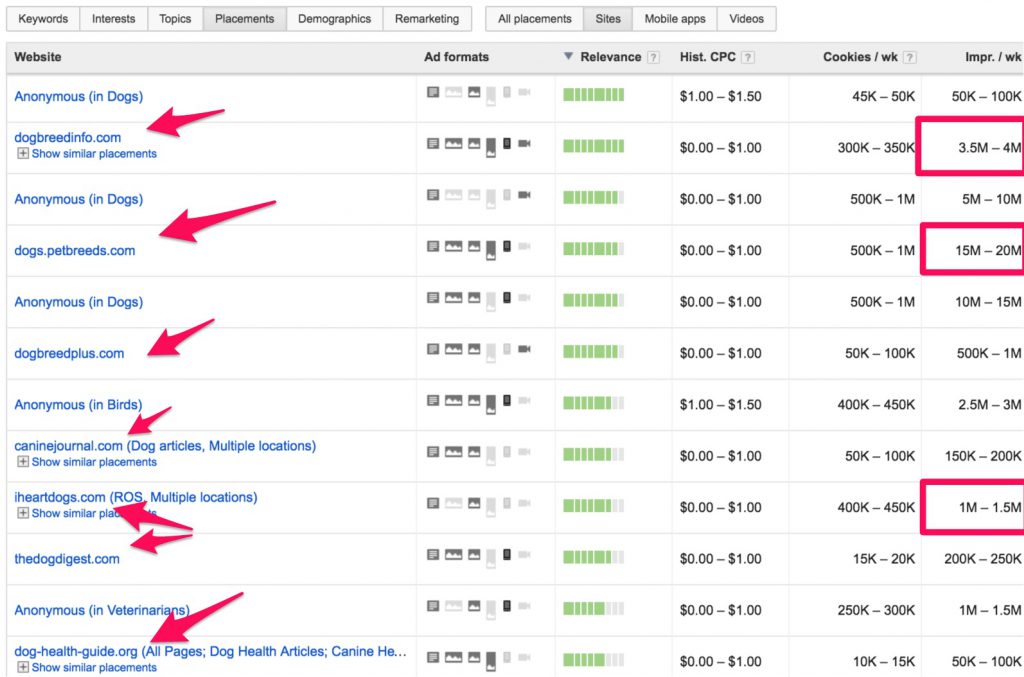
Now, all you have to do is see is take notes of these sites and see if you can guest post or partner in any way with them to piggyback their traffic, just like I showed you in the previous hack.
7. Publish More Often Without Creating New Content
So far in this article, I have shown you how to find content that works better and gets you shares and links. That way, instead of coming up with new ideas, you’d simply borrow them. But if you want to go the classic way and create content that fits your audience’s needs and problems (which you should still do, regardless of how many shares or links you get), it can take you some time to get those ideas.
You have some techniques that make it easier, like brainstorming, persona development, reverse engineering, and much more. But there’s one way that makes this process really easy—so easy, you barely have to spend any time finding those topics.
No, I’m not talking about stealing ideas. This is even easier—and more ethical. I’m talking about repurposing old content.
If you have been publishing content for more than a year, you probably have dozens of articles, videos, infographics, and slide decks published. What if you just take those old ideas and create new content, but under a new format? If you created an article, you would turn it into a video. If you have created a Q&A, you would create an infographic. If you have made a slide deck, you would create an article. You get the drift.
This hack is super easy to implement, and it can help you save a lot of time. For instance, if you were Noah Kagan, the CEO and founder of Sumo (a suite of tools for blogs that also runs a great online marketing blog), I would suggest he adapt the following ideas based on his latest blog posts:
- Create a video for their “5 Ideas To Make Black Friday Money The Other 364 Days Of The Year” article.
- Create an ebook for lead generation for their article “The 7 Step Guest Posting Process to Guarantee Email List Growth.”
- Create a slide deck presentation for their “Email Marketing for Ecommerce: 12 Essential Strategies to Build Your List” article.
- Create a case study for the review Nate Desmond did for WP101 blog.
These are just a few ideas I came up with by skimming through their blog. There are countless more ideas that could be thought of with a little bit of time. The point is this: take your old content and repurpose it. Make sure to update it, and if possible, use it along with the rest of the hacks. For instance, you can repurpose a piece of content, use it for guest posting while optimizing for links or shares (based on your analysis), and finally, offer a content upgrade to get more people to visit your site.
That’s what this article is all about: hacking your content marketing for the best results possible.
And there you have it: the seven growth hacks to improve your content marketing and grow your traffic. If you want to take these seven content marketing hacks with you and implement them in a step-by-step fashion, you can download the FREE checklist and use it whenever you want.
Either way, if you use the hacks I showed you on this article, you will be able to take your content marketing to the next level. Sure, you will still have to work hard to get your results, but your chances of succeeding will be much higher.
Have you ever tried any of these seven tactics? If so, what was your experience? Share your experiences in the comments below.

